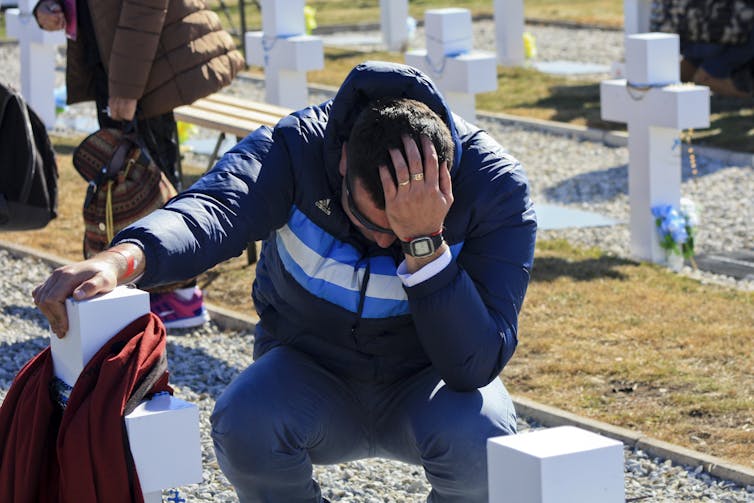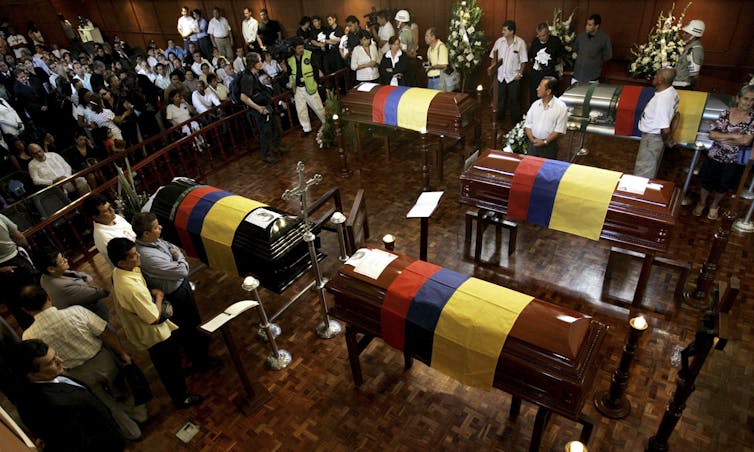Humanitarian forensic scientists trace the missing, identify the dead and comfort the living
- Written by Ahmad Samarji, Associate Professor of Forensic Science Education & STEM Education and the Assistant Dean of the College of Arts and Sciences, Phoenicia University
The word “forensic” is typically associated with crimes and legal disputes. Forensic medicine[1], for example, applies medical knowledge to establish the causes of injury or death.
But forensic science can have a humanitarian role[2], too. Working under international humanitarian law rather than local or federal criminal systems, these forensic experts help ensure the proper identification and respectful handling of people who die during war, natural disaster and migration[3], preventing them from becoming missing persons.
We are forensic scientists who have studied[4] and organized[5] international conferences about the forensic work required at conflict zones and natural disaster sites. And we’d like to introduce the world to this emerging profession[6], which is expanding across the globe.
Natural disasters
Interpol, the international police agency, publishes global standards for appropriately identifying and handling the dead[7] after major disasters. But achieving those standards may be beyond local authorities’ abilities when the death toll is very high and simply finding and identifying casualties presents a challenge.
Starting in 2004, the International Committee of the Red Cross developed the concept of “humanitarian forensic action[8]” to ensure that those who die in war, disaster and other complex emergencies are treated respectfully and with dignity[9] and don’t become missing persons.
The Red Cross’ forensic humanitarians work closely with local authorities worldwide, as well as train, brief and supervise other aid workers, to ensure the proper and dignified management of the dead while the laborious process of identification is underway.
Its experts were on hand after Mozambique’s deadly 2019 typhoon in which over 1,000 people died. They were there after Haiti’s 2010 earthquake[10], which killed an estimated 230,000, and Super Typhoon Haiyan[11], which devastated the Philippines in 2013.
Conflict
Humanitarian forensic experts also help factions in armed conflicts fulfill their international obligations towards the dead in battle.
The 1949 Geneva Convention[12] and subsequent agreements require that the dead are searched for, collected, documented, identified and disposed of in a dignified manner, ideally by returning the remains to bereaved families.
Decades after Argentina and the United Kingdom went to war over the Falkland Islands, which are known as the Islas Malvinas in Argentina, the two countries agreed[13] in 2016 to invite the Red Cross to exhume 122 unnamed soldiers buried in the Darwin military cemetery on the islands in what became a model of humanitarian forensic action.
Using a variety of forensic disciplines – such as anthropology, archaeology, pathology, dental testing and DNA analysis – the humanitarian forensic experts successfully identified nearly all of the 122 unknown soldiers.
The exhumed Falklands War dead were later reburied in new coffins in marked graves, and the cemetery restored to its original shape. In March 2018, after 35 years of suffering and uncertainty, more than 200 family members visited[14] the cemetery to pay their final respects.
 The relative of an Argentine soldier killed in the Falklands War with Britain grieves at the Darwin Military Cemetery on Falkland Islands (Islas Malvinas), March 26, 2018.
AP Photo/Caiti Beattie[15]
The relative of an Argentine soldier killed in the Falklands War with Britain grieves at the Darwin Military Cemetery on Falkland Islands (Islas Malvinas), March 26, 2018.
AP Photo/Caiti Beattie[15]
Humanitarians in danger
In conflict zones where militants are engaged in battle against their own governments, the official rules of war may not apply.
In such places, the job of the humanitarian forensic expert involves negotiating the humane treatment of dead bodies, the return of human remains to the families and the honorable disposal of bodies according to the rites of their religion or faith.
This can be dangerous.
In 2007, the Red Cross’ humanitarian forensic team was asked to help in the recovery of the bodies of 11 legislators who had been abducted by the FARC[16], a Colombian guerrilla movement, five years before and had recently died[17] under contested circumstances.
The guerrillas said the hostages died in a botched rescue operation by government forces, while the government accused the guerrillas of executing them[18].
After a lengthy negotiation, both sides agreed on a brief ceasefire while the Red Cross team collected the bodies. Locating the burial site of the bodies took days, according to Dr. Morris Tidball-Binz[19], a leading forensic expert with the International Committee of the Red Cross.
He and his colleagues walked for dozens of miles through the Colombian jungle, some of it defended with landmines[20].
“At night, there were a couple of occasions when we heard explosions around, which indicated the fragility of the ceasefire,” Dr. Tidball-Binz recalls[21].
Humanitarian workers undertaking similar conflict-related identification of the dead have become targets of direct or indirect threats in Argentina and Libya[22].
 The coffin of five lawmakers who died in FARC captivity are seen during their funeral in Cali, Colombia, Sept. 12, 2007.
Reuters/Jaime Saldarriaga[23]
The coffin of five lawmakers who died in FARC captivity are seen during their funeral in Cali, Colombia, Sept. 12, 2007.
Reuters/Jaime Saldarriaga[23]
Missing persons and migration
International humanitarian law includes another difficult-to-meet obligation[24]. Families are supposed to be informed about the fate and whereabouts of loved ones who go missing during war[25] or armed conflict[26].
After gathering all information possible[27] about the missing person based on the physical evidence available, they closely collaborate with family members to paint a more complete picture of the victims, using DNA, identifying marks and personal belongings to try to identify a missing person.
This is sensitive work. War survivors may be hesitant to speak about missing loved ones because they fear retaliation from the government or an armed faction. Yet family cooperation is essential to locating and identifying those missing in war.
Humanitarian forensic scientists have also played a fundamental role in Europe’s migrant crisis, which has claimed the lives of thousands who die or go missing in the Mediterranean Sea[28] attempting to flee Africa and the Middle East.
After a boat packed with migrants[29] sank several miles off the coast of Rasheed, Egypt, in September 2016, for example, just 163 people were rescued. Thirty-three were found dead inside the boat and 168 people drowned.
Scientists from the Egyptian Forensic Medicine Authority were called to the scene to identify the dead[30] and establish their cause of death.
Humanitarian forensic scientists don’t always succeed. Sometimes, their investigations reach a dead end. The fate of those missing remains a mystery.
In the best-case scenario, though, the difficult work of these humanitarian scientists brings closure to families so that they can start mourning their loss.
[ You’re smart and curious about the world. So are The Conversation’s authors and editors. You can read us daily by subscribing to our newsletter[31]. ]
References
- ^ Forensic medicine (www.sciencedirect.com)
- ^ humanitarian role (www.icrc.org)
- ^ migration (migrationdataportal.org)
- ^ studied (theconversation.com)
- ^ organized (forensic.meetinghand.com)
- ^ emerging profession (www.icrc.org)
- ^ appropriately identifying and handling the dead (www.interpol.int)
- ^ humanitarian forensic action (www.icrc.org)
- ^ treated respectfully and with dignity (www.who.int)
- ^ 2010 earthquake (www.nytimes.com)
- ^ Super Typhoon Haiyan (theconversation.com)
- ^ 1949 Geneva Convention (www.weaponslaw.org)
- ^ agreed (www.icrc.org)
- ^ visited (www.nodal.am)
- ^ AP Photo/Caiti Beattie (www.apimages.com)
- ^ abducted by the FARC (www.theguardian.com)
- ^ recently died (www.latimes.com)
- ^ accused the guerrillas of executing them (www.nytimes.com)
- ^ Dr. Morris Tidball-Binz (www.icrc.org)
- ^ landmines (www.reuters.com)
- ^ recalls (www.icrc.org)
- ^ Argentina and Libya (www.icrc.org)
- ^ Reuters/Jaime Saldarriaga (pictures.reuters.com)
- ^ obligation (ihl-databases.icrc.org)
- ^ war (www.hrw.org)
- ^ armed conflict (www.laht.com)
- ^ all information possible (en.oxforddictionaries.com)
- ^ die or go missing in the Mediterranean Sea (www.iom.int)
- ^ boat packed with migrants (www.thenewhumanitarian.org)
- ^ identify the dead (www.reuters.com)
- ^ You can read us daily by subscribing to our newsletter (theconversation.com)
Authors: Ahmad Samarji, Associate Professor of Forensic Science Education & STEM Education and the Assistant Dean of the College of Arts and Sciences, Phoenicia University

